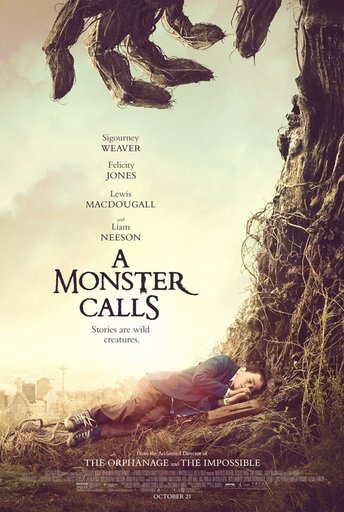Written by Mike Cervantes It’s that time of the year again, where the would-be film critic fills the odd lull at the beginning of January by going back and seeing all the films that they missed at the end of the previous year. A Monster Calls certainly fits the bill, since it was released limited on December 23rd, and is only just being picked up by general theatres and movie outlets all across the web. This Spanish/American co-production, based on the novel by Patrick Ness, follows the story of Conor O’Maley (Lewis MacDougal) a creative ten year old who is struggling with loneliness and school bullies, but mostly the slowly failing health of his cancer-stricken mother Lizzie (Felicity Jones). One night, after a viewing of King Kong, Conor decides that a giant monster is the ideal way for him to deal with his problems. That night, a giant yew tree in the cemetery across from his house reveals itself to be that very giant monster (voice of Liam Neeson). His quest: to tell Conor 3 stories of grief and injustice, leading Conor to tell him the fourth, the outcome of which will decide whether Conor himself lives or dies based on his own grief. Right away, some pretty obvious tropes make themselves present: the monster is both a metaphor for and an allegory of Conor’s mounting grief over his mother. He is always present whenever Conor does something to deal with his pain, ultimately hurting his grade school tormenter (James Melville) and his grandmother (Sigourney Weaver) in the process. This film was, at different points, marketed as a PG psychological thriller, and then as a full blown fantasy movie. But it’s really neither. Rather it is a film that explores the simplicity of child-like emotion, combining concepts found in both The Neverending Story, and Bill Watterson’s Calvin and Hobbes comic strips. Also, while the general idea behind the film is pretty obvious, you have to take a cue from what the movie itself tells you: it’s not the story, but what you take away from it.  Someday, this film will be held up in college film classes and critical archives as the ideal example of how to tell a story using modern film techniques. That isn’t an exaggeration. After a whole summer of CG-saturated films with building-block plots surrounded by epic set pieces, this movie takes a budget of $43 million and uses the exact same techniques to tell a story that results in immersion, emotion, and heart. It is eclectic in its use of CG, not just to create the giant yew tree monster, but also to illustrate two of the three stories it tells in different art styles, disguising itself just enough to provide an interesting contrast from the rest of the film. It also combines neatly with the live action, culminating on a practical effect in the third act which I won’t spoil, but it amounts to just about the most awesome scene I’ve seen in a fantasy film of recent memory. As great as the CG is, however, it takes a backseat to the storytelling techniques present in the reality scenes. An especially grounded subplot involving the relationship between Conor and his estranged father (Toby Kebbell) works well within the film despite having none of the more fantastical elements within it. The whole film is a filmmaker’s study of “show don’t tell” techniques, as we’re guided constantly by the atmosphere of the story, despite having basically figured things out from the beginning. Just like the previous year’s Kubo and the Two Strings, the film justifies whatever cutting edge techniques it uses by creating for the viewer a world that contains the concept of its ingenuity: pure imagination. I was in awe of some moments, and I cried in others. Ignoring all the previous release dates, I can confidently say that this is the first great film of 2017. Watch it in the theater if you still can, and please catch it elsewhere if you can’t. It is an absolute must see.
0 Comments
Leave a Reply. |
Archives
March 2025
|
|
© 2012-2025, Nerds That Geek LLC.
All Rights Reserved. |
uWeb Hosting by FatCow


 RSS Feed
RSS Feed